Chasen, Chabana, and Buddhism
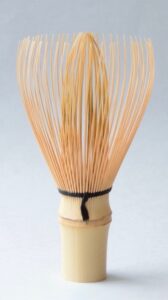
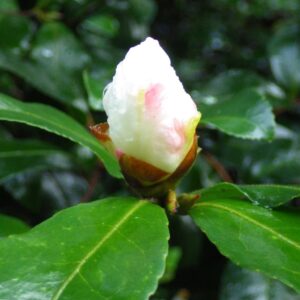
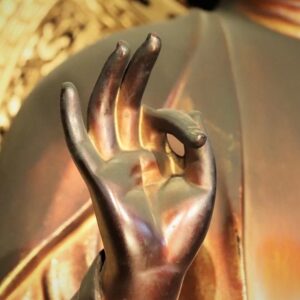
Cha-no-yu, 茶の湯, Tea-’s-hot water, is sharing tea with others. In its early days, tea was a medicine used for many purposes. Tea came in many forms, and in Buddhism, tea was drunk before meditation, to keep awake. When offered to the Buddha and other revered spirits, procedure and protocol was established. Flowers are an essential offering to the Buddha, and the most important flower is the lotus, hasu, 蓮. When Zen Buddhism was brought to Japan it came together with a way of preparing and drinking tea. Tea became inseparable from Zen.
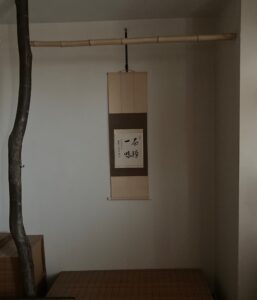
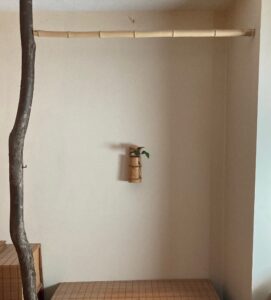
(a) The kake-mono, 掛物, hang-thing, shiki-shi, 色紙, color-paper, paperboard with calligraphy ‘‘Cha Zen Ichi Mi’, 茶禅一味, Tea Zen One Taste, by Yama–guchi En-dō, 山口円道, Mountain-opening Circle-way, abbot of Man-shu-in, 曼殊院, Wide-especially-temple, Kyōto.
(b) Suspended on the back wall of a tokonoma is a camellia flower in a kake-hana-ire, 掛花入れ, hang-flower-receptacle, striated shibo-chiku, 絞竹, wring-bamboo, ichi-jū-giri, 一重切, one-tier-cut; H. 9.5 sun kane–jaku, made by Nishi-kawa Bai-gen, 西川楳玄, West-river Prunus-mystery, Taka-ga-mine, 鷹ヶ峰, Hawk ’s Peak, Kyō-to, 京都, Capital-city.
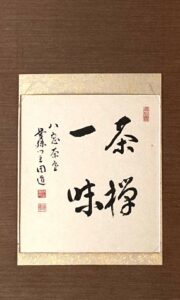
Detail of kake-mono, 掛物, hang-thing, with shiki-shi, 色紙, color-paper, pasteboard with calligraphy, ‘Cha Zen ichi mi’, 茶禅一味, Tea Zen one taste, written by Yama–guchi En-dō, 山口円道, Mountain-opening Circle-way, abbot of Man-shu-in, 曼殊院, Wide-especially-temple, Kyōto. This imperial retreat was changed into a Buddhist temple, and has an important tea hut named, Ha-ssō-ken, 八窓軒, Eight-window-eave. Signed: Ha-ssō Cha-shitsu, Eight-window Tea-room, Man-shu Mon-shu En-dō, 曼殊門主円道, Wide-especially Gate-master Circle-way. With red ink stamps for the temple and author. The scroll is hung on an adjustable metal ji-zai kake, 自在掛, self-exist hanger, which hangs from a bamboo kugi, 釘, peg.
In the Japanese culture of Chanoyu, before tea is prepared, a meal is served, and in the course of the development of Chanoyu, the Tea gathering was divided into two parts. For the first part, the revered scroll was displayed, and in the second part, the flower was displayed in its stead. Tea and the word are manifestations negative and positive aspects: Yin and Yang, In and Yō, 陰陽.
The essence of Cha-no-yu, 茶の湯, Tea-’s-hot water, the Japanese Tea Ceremony, is manifested in the Cha-ji, 茶事, Tea-matter. The Chaji is a gathering of people where the host builds a charcoal fire, offers something to eat, and serves a bowl of whisked green tea. The basic Chaji is divided into two parts; sho-za, 初座, first-seating, and go-za, 後座, latter-seating, which are also called sho-iri, 初入り, first-entry, and go-iri, 後入り, latter-entry.
Chanoyu is traditionally presented in a cha-shitsu, 茶室, tea-room, which is ideally, a yo-jō-han, 四畳半, four-mat-half. An integral feature of traditional Japanese architecture, is a toko-no-ma, 床の間, floor-’s-room. In an ideal chashitsu the tokonoma is located in the north. A tokonoma is for the display of fine and meaningful objects. In Chanoyu, such objects are a kake-jiku, 掛軸, hang-scroll, and hana, 花, flowers. During the first seating of the Chaji, when the meal, kai-seki, 懐石, heart-stone, is served, the kakejiku is displayed in the tokonoma. During the latter seating when tea, ma-tcha, 抹茶, powdered-tea, is presented, the cha-bana, 茶花, tea-flower, is displayed in the tokonoma.
The Tearoom is darkened for the sho-za, 初座, first-seating, when the scroll is displayed, and brightened for go-za, 後座, latter-seating, when the flower is displayed. This is accomplished in small Tea huts, by having removable sudare, 簾, reed blinds, that cover the small windows. The sudare are hung on the outside of the building prior to shoza, and are removed by the host while the guests are re-entering the Tearoom for goza.

The Zen ‘word’ is, in essence, the same as the flower. The written word is an aspect of the positive principle of Yō, 陽, Yang, because the spoken word is incorporeal and timeless. The living natural flower is an aspect of the negative principle of In, 陰, Yin, because it is corporeal, temporal.
The Zen scroll and the flower, when it is displayed on the back wall of the tokonoma, are both hanging objects, which seems natural for the scroll, but the flower seems somewhat mystical because it appears to be floating in the air. The brain ‘knows’ that the hanaire is hanging from a hook, yet, it ‘feels’ that it is hanging in mid-air, perhaps even held by an invisible ‘hand’ – the hand that wrote the words. In an ideal situation, the flower alone, by itself, should be floating in space.
The hanging scroll, preferably, has phrases or texts related to or inspired by Zen Buddhism, and that are frequently written by Zen priests or other Buddhist priests. The Ie-moto, 家元, House-origin, of the Sen families must study under Zen priests and become ordained as lay priests. One of the most familiar phrases in Chanoyu such as ‘Cha Zen Ichi Mi’, 茶禅一味, Tea Zen One Taste, which Takeno Jō-õ taught Rikyū. Another familiar phrase ‘Yanagi wa midori hana-kurenai’, 柳わ緑花紅, Willow is green flower is red, which was adapted from the ‘Ten Ox Pictures’. The Kanji, kurenai, 紅, also means ‘dark not’.
Flowers have been offerings to revered spirits from the earliest days of belief. They are beautiful and last for a brief period of time. This is why cut flowers are displayed in the tokonoma for a Tea gathering. To set the theme and mood of a Tea gathering, some Buddhist words or phrases are displayed on a hanging scroll. Thus, a tokonoma for Tea has an inspirational scroll and flowers displayed in the tokonoma.
The word ‘tokonoma’ is written with the Kanji, 床の間, floor-’s-room. The Kanji, 床, also means bed, is based on the Kanji, 牀, which is composed of the Kanji, shō, 爿, half a tree, and ki, 木, wood/tree, by the side of a tree.
It is necessary for the teishu to enter the tokonoma to hang the scroll and flower, the guest should not enter the tokonoma unless permitted by the teishu. Aspects of the origin of the tokonoma included an elevated room where the nobility sat. In Chanoyu, there are several procedures in which the guest may enter the tokonoma: Jiku-kazari, 軸荘, Scroll-dignify, hanging the scroll; hana-yose, 花寄せ, flower-donate, one or more persons place flowers in various hana-ire, 花入, flower-receptacle; mawari-bana, 回り花, circuit-flower, several persons in sequence, place, replace, exchange, switch, re-arrange flowers in a single hanaire. The word ‘mawari’ also means revolve, rotate, go around, etc.
When preparing the chawan for making tea, the whisk is placed in the bowl that contains hot water, and is raised and turned, mawaru, 回る, to rotate, to examine and soften the bamboo tines, which is called chasen tōshi.
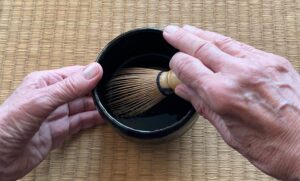
Cha-sen tōshi, 茶筅通し, tea-whisk pass through, is the procedure of rinsing and inspecting the tea whisk before making tea. The chasen is placed in a chawan with the right hand, the handle is rested on the right side of the rim. The chasen is re-held and raised to inspect the tines and its general condition, and the chasen is rotated ¼ turn, and rested again on the rim of the bowl. The chasen is raised and rested two or three times depending on the Tea presentation. There are exceptions. After the chasen is rested, it is rapidly whisked in the water, drawing the hiragana character no, の, and removed. The middle finger is used to pivot the chasen.
When picking up the chasen from the floor, the handle of the chasen is held with the thumb, fore-finger, and middle finger of the right hand. The thumb is placed directly below the musubi-me, the forefinger on the opposite side. The other three fingers are extended. The position of the hand may be identified as a mudra, in-zō, 印相, sign-phase, or hand gesture, present in Hinduism and Buddhism. A similar mudra is the hand gesture of Amida, the Buddha of Compassion.
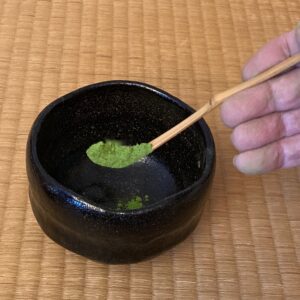
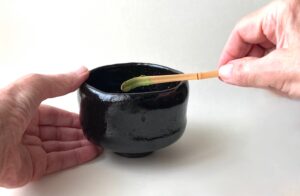
Tea in early Japan was made and served in a conical Tenmoku chawan. One might wonder why the form of the chawan was changed from the Tenmoku to the ‘Raku’-form bowl. It is thought that Rikyū, and others, may have changed the form of the bowl from the conical form to one that was more suitable for the movement of the chasen. Using a chasen to make tea may have been the critical element. Tea in the Song dynasty was made in the conical Tenmoku bowl. It was powdered, aged, fermented tea that settled in the bowl, rather than becoming an emulsion, suspended in the water as with matcha.
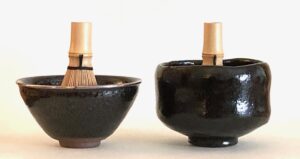
In the Song period, tea was prepared and drunk in various ways, including dried, fermented, aged, green, etc. When green tea leaves were ground to a powder, and blended with a whisk, the tea particles remained suspended in water for a time, but eventually would settle. When tea is stirred quickly with a bamboo whisk, the tea foams. It appears that the form of the Tenmoku lent itself to spinning the whisk rather than simply moving it back and forth. Tea may have been made in the Tenmoku by twisting the chasen.
The conical form of the Tenmoku impedes the brisk action of the whisk, so that the form of the bowl was changed to accommodate the movement of the whisk. The whisk could move back and forth, tate, 點, offer, in the bowl with the flatter bottom, rather than simply twisting around and back.
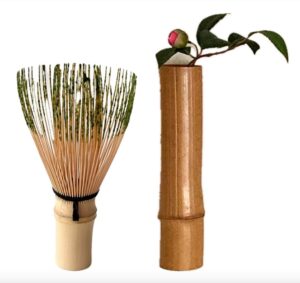 Pictured above is a chasen and a hanaire, it must be understood that they are not the same size. The proportions of the chasen and the hanaire have the fushi in the same relative location. Another aspect is that the tines of the chasen are at the bamboo’s root end, as though it is growing out of the tea, while the bamboo root end is at the bottom of the hanire, as though it is growing out the ground.
Pictured above is a chasen and a hanaire, it must be understood that they are not the same size. The proportions of the chasen and the hanaire have the fushi in the same relative location. Another aspect is that the tines of the chasen are at the bamboo’s root end, as though it is growing out of the tea, while the bamboo root end is at the bottom of the hanire, as though it is growing out the ground.
Chabana should be sprinkled with tsuyu, dew, prior to the arrival of the guests. The Kanji for dew, ro’ , that for a Buddhist means ‘enlightenment’. It should be noted that both the dew-laden flower and the tea are wet, In
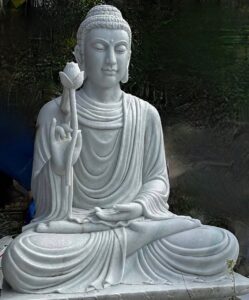
When making a bowl of matcha, Buddhist priests hold the bowl on the left hand in a manner similar to the position of Buddha’s left hand.
In Zen Buddhism, the transition of leadership passed from the Buddha to one of his followers, is described in the ‘Nen-ge mi-shō’, 拈華微笑, twirl-flower delicate-smile, which is called the ‘Flower Sermon’. This is the foundation of Zen called, I-shin den-shin, 以心伝心, by-heart transmit-heart; non-verbal Zen Buddhist transmission to a disciple of the central tenets of Buddhism.
The original event is presented in the Buddhist text of the Flower Sermon:
When the Buddha transferred leadership of the Sangha, a great assembly gathered at Ryō-ju-sen, 霊鷲山, Spirit-vulture-mountain, in English referred to as Vulture Peak. Buddha held in his right hand and twirled the flower of a lotus, hasu, 蓮. All were silent, Maha-ka-sha-pa, Ma-ha-ka-shō, 摩訶迦葉, Polish-scold (great) [Sound]-leaf, smiled. Seeing that Mahakashapa ‘understood’, the Buddha made him the leader of the group because ‘enlightenment’ passed directly from the Buddha to Mahakashapa. This direct transmission is the foundation of the development of Chan (Zen), 禅, Buddhism. Understanding is not necessarily gained through vast study and learning, but is transmitted through direct experience.
The lotus is deeply connected to Buddhism, however, the lotus flower is inappropriate as cha-bana, 茶花, tea-flower. Lotus blossoms are often very large, and a single lotus bud is symbolic of Buddhist death. It should be remembered that the style of chabana is very different from ike-bana, 生花, live-flower. Shio-tsuki Ya-e-ko, 塩月弥栄子, Salt-moon Increase-splendor-child, first born of the 15th generation of Urasenke does not include the lotus in her lavish and creative book, ‘Cha-bana Goyomi’, 茶花ごよみ, Tea-flower choice, published by Kakugawa Shōten. The lotus may be perceived as too religious.
According to Shiotsuki’s ancestor, Sen no Rikyū, a particular species of small and attractive water lily, the kō-hone, 河骨, river-bone, Japanese spatterdock, Nuphar japonica, is singled out as inappropriate for chabana, because of its unpleasant sounding name.
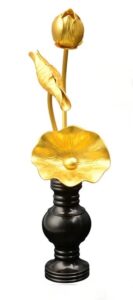
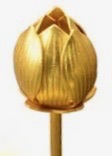
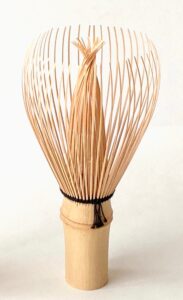
Gilt bronze lotus in black patinated hana-tate, 花立 , is part of a set of Buddhist altar offerings. The Kanji for flower bud, 蕾, is composed of the grass radical, 艹, plant, and kaminari, 雷, lightning. The chasen may be likened to the Buddha’s lotus, as well as to the vajra, the lightning bolt of Indra, king of the Hindu gods, known in Japan as Tai-shaku-ten, 帝釈天, Emperor-explain-heaven (Deva). No thing is just one thing.
For further study, see also: Chasen, Chasen and Tea, Chasen and the Gorintō, Chasen Suehiro, Chasen Whisk and Thread, Chasen and Sensu, Natsume Chasen Chashaku

